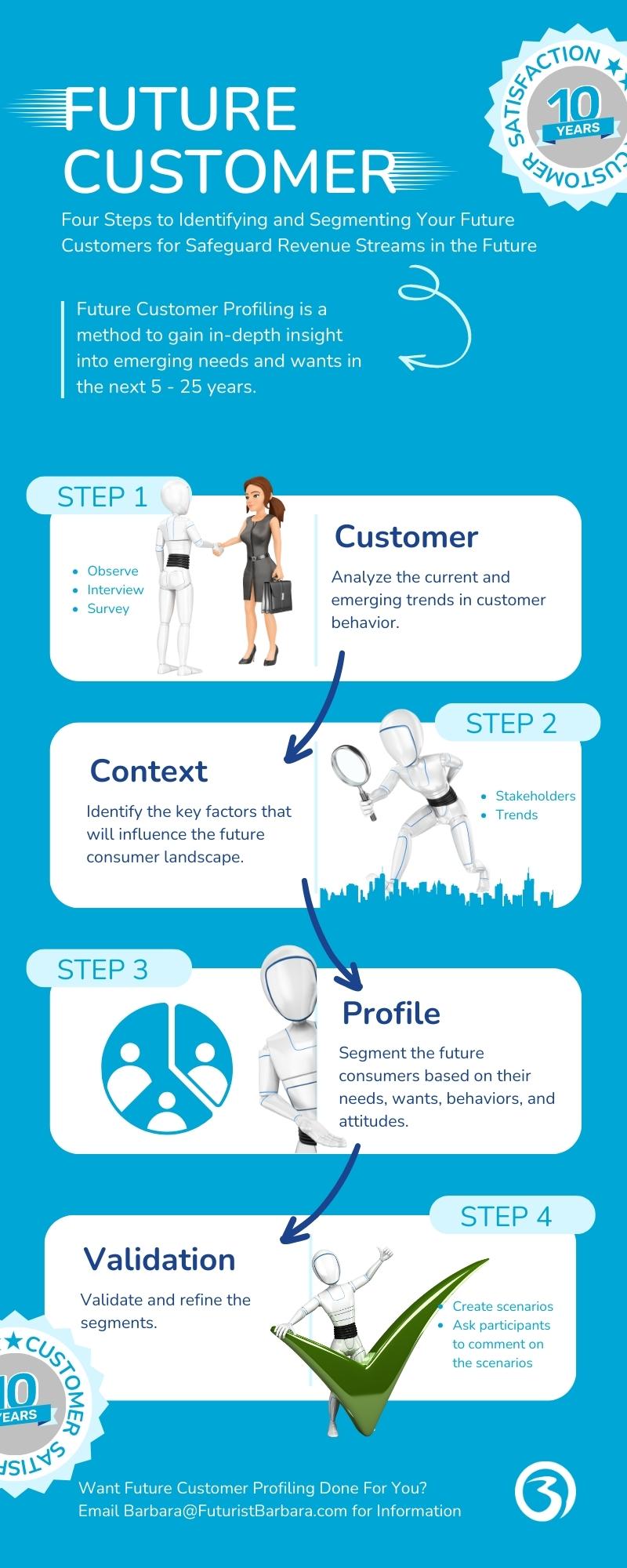
Looking beyond your existing customer base and imagining new groups of potential customers drives your organization's performance in the future. In this article, we will explore the concept of future customer profiling and its significance in achieving sustained revenue and profitability.
Futures Thinking
Funny as it may sound, but for future customer profiling you have to use historical analogies. You take a look at the past to see how the needs and wants of a particular group of people have changed over time. You use that information to make predictions about how their needs and wants might change in the future.
For example:
- What are the needs and wants of my current customers in the 25-35 age range?
- What were the needs and wants of this age group 5 to 10 years ago?
- How have the needs and wants of this age group changed over the past 5 to 10 years?
- Do I think that the needs and wants of this age group will continue to change in the same way in the next 5 to 10 years?
Let's take the example a little further. If your current customers are in the 25-35 age range, and they are looking for products and services that help them stay active and healthy, then you can assume that future customers in the same age range will also have similar needs.
However, it's important to remember that the world is constantly changing, and so are the needs and wants of consumers. So, you'll also need to factor in external factors such as social and economic trends, technological advances, and cultural changes.
For example, if the trend towards urbanization continues, then future customers in the 25-35 age range may be more likely to live in cities than in rural areas. This could mean that they want to have those needs to stay active and healthy fulfilled differently.
Ultimately, the goal of future customer profiling is to develop a deep understanding of the needs and wants of potential customers. When you understand these needs and wants, you can position your organization to meet them and provide new growth opportunities.
You'll have a good sense of:
- the trends that are likely to impact the needs and wants of your customers,
- the possible directions in which your customers' needs and wants might change,
- the strategies you can deploy to meet the needs of their customers in the future.
Step 1: Changes in Consumer Behavior
Analyze the current and emerging trends in consumer behavior, preferences, values, and expectations. KPMG’s Five My's framework is a handy tool to understand the complex drivers of consumer behavior. KPMG used it to profile new needs and wants post COVID, but we can use it too:
- My Motivation: What drives consumers to buy certain products or services, such as convenience, quality, price, or social impact.
- My Attention: How consumers allocate their time and attention across different channels and platforms, such as online, offline, mobile, or social media.
- My Connection: How consumers interact with brands and other consumers, such as through loyalty programs, reviews, referrals, or communities.
- My Watch: How consumers monitor their health, wellness, finances, and security, such as through wearable devices, apps, or online tools.
- My Wallet: How consumers manage their spending and payment methods, such as through cash, credit cards, digital wallets, or cryptocurrencies.
Step 2: Influential Changes in the Context
Identify the key factors that will influence the future consumer landscape, such as technology, social change, environmental issues, economic conditions, and regulatory developments. For an example, take a look at some of the shifts that Bain & Company describes:
- New laws of gravity in consumption: The acceleration of online commerce and the rise of at-home consumption due to the pandemic and social distancing measures.
- The great rebalancing of supply and demand: The shift in consumer demand from discretionary to essential categories and the need for supply chain resilience and flexibility.
- The green reboot: The increased awareness and action on environmental sustainability and social responsibility among consumers and businesses.
- The new deal on data privacy: The growing concern and regulation on data protection and privacy as consumers share more personal information online.
Or do the research yourself by monitoring emerging technologies, disruptive business models, and innovative products or services. Look beyond mainstream markets and explore fringe and niche groups that might be indicative of future customer preferences. These groups often exhibit early signs of emerging trends.
-- Continues below infographic --

Step 3: Create Segments
Segment the future consumers based on their needs, wants, behaviors, and attitudes. For example, you can use Forbes’ four types of customers of the future to categorize them according to their level of connection and progress. These types are:
- The Connected Customer: These are customers who value convenience and speed above all else. They want seamless and personalized experiences across all touchpoints. They are always online and use multiple devices to access information and services.
- The Progressive Customer: These are customers who are always looking for new and innovative products and services. They are early adopters of new technologies and trends. They are willing to pay a premium for quality and differentiation.
- The Conscious Customer: These are customers who care about the social and environmental impact of their purchases. They seek brands that align with their values and beliefs. They are loyal to brands that demonstrate transparency and authenticity.
- The Hybrid Customer: These are customers who combine aspects of the other three types depending on the context and situation. They are flexible and adaptable to changing needs and preferences. They expect brands to offer them options and choices.
Step 4: Validate and refine the segments.
Use data and insights from various sources, such as surveys, interviews, social media, analytics, and experiments. For example, you can use Blake Morgan's book “The Customer of the Future” to learn how to leverage the latest thinking and strategies to serve the customer of the future and win tomorrow’s business. The book provides 10 easy to follow customer experience guidelines that can help you create a distinctive, personalized, and intentional customer experience. Some of these guidelines are:
- Know your customer better than anyone else: Use data and analytics to understand your customer’s needs, wants, preferences, behaviors, emotions, and expectations.
- Embrace technology innovation: Use technology to enhance your customer experience by creating convenience, efficiency, personalization, engagement, and differentiation.
- Create a consistent omnichannel experience: Deliver a seamless and consistent experience across all channels and touchpoints by integrating your online and offline presence.
- Empower your employees: Train and motivate your employees to deliver exceptional service and create emotional connections with your customers.
Evidence
- According to a study by Harvard Business Review, companies that are good at identifying future customer segments are more likely to grow their revenue and profits. The study analyzed data from more than 1,000 companies across 12 industries and found that the top performers in customer value creation had a clear vision of who their future customers were and how their needs and preferences differed from those of their current customers. They also invested in developing products, services, and experiences that appealed to these emerging segments, while maintaining their existing customer base. The study suggests that companies can improve their customer value creation by adopting a customer-centric mindset, using data and analytics to identify and anticipate future customer trends, and aligning their organization and culture around delivering superior customer value.
- According to a study by McKinsey & Company, companies that are good at identifying future customer segments are more likely to be successful in new markets. The study analyzed data from more than 40,000 consumers across 19 countries and found that there are two distinct segments of consumers: the “loyalists” and the “switchers”. The loyalists are those who stick to their preferred brands and categories, while the switchers are those who are willing to try new products and services. The study suggests that companies can increase their market share and profitability by targeting the switchers, who represent about 40 percent of the global consumer market. The study also provides insights on how to identify, attract, and retain these switchers, such as offering personalized experiences, leveraging digital channels, and creating innovative value propositions.
Take Action
Are you ready to unlock the potential of future customer profiling? Let's embark on this exciting journey together! Connect with me on LinkedIn for starters.
Fresh Foresight Insights Directly in Your Inbox
Join Barbara's mailing list to receive her latest Canary and updates about her research into managerial foresight and blind spots.
I hate SPAM too, so know that I won't spam or have others spam you!

